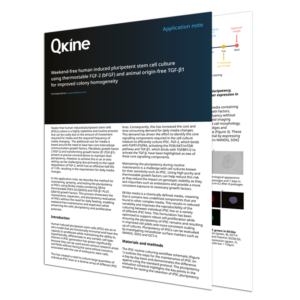Lukasz Truszkowski, Sveva Bottini, Sara Bianchi, Silvia Becca, Giulia Savorè, Kirsten E Snijders, Federica Sozza, Cristina Rubinetto, Elisa Balmas and Alessandro Bertero from HEDGe, University of Turin.
Helen Bell, Luana Ferrara and Catherine Elton from Qkine, Cambridge, UK.
This recent publication from the Bertero Lab in collaboration with Qkine focusses on the optimization of media for the maintenance of human induced pluripotent stem cells (hiPSCs) to allow cost-effective, practical, and reproducible culture of hiPSCs. High quality, reproducible but cost-effective culture is especially crucial for large-scale expansion of hiPSCs for cell therapy, which should be made accessible to many patients regardless of their socioeconomic background.
During the optimization of media for weekend-free hiPSC culture the Qkine tag-free FGF2-G3 variants were found to be too potent at the recommended concentration of 40 ng/ml. When lower concentrations were tested pluripotency was increased, indicated by the number of NANOG/OCT4 positive cells. The optimal concentrations were determined to be 10 ng/ml for FGF-G3 154 aa (Qk053) and 5 ng/ml for FGF2-G3 145 aa (Qk052). FGF2-G3 145 aa reduced the cost of FGF-2 in the media by 2-fold, in addition to the cost reduction made by using the weekend-free media change protocol.
- FGF2-G3 145 aa optimal concentration (5 ng/ml) was 2-fold less than FGF-G3 154 aa (10 ng/ml) and 8-fold less than recommended FGF2 (40 ng/ml).
- B8+ optimized media was developed with 1ng/ml TGF-β3 (Qk054), 5 ng/ml FGF2-G3 145aa (Qk052) and 0.1 ng/ml NRG-1 (Qk045) [full media in publication].
When compared to commercially available E8 media (cE8) and homemade E8-like media (hE8), hiPSCs cultures in B8+ media had the highest NANOG expression and an enrichment of genes indicting a move towards mesodermal or endodermal differentiation rather than neuronal differentiation. However, despite this change the hiPSCs remained pluripotent for at least 10 passages.
B8+ also improved the efficacy of gene-editing compared to cE8 and hE8 media, showing increased resilience of the cells to the stress of the selection procedure. All the media were able to support the differentiation of iPSCs towards cardiomyocytes, a mesodermal derivative, with the addition of activin A (Qk001) and BMP-4 (Qk038) [full media in publication]. All media also supported the formation of cardiac organoids and their differentiation into TNNT2+ cardiomyocytes.
- Costs of the media were ~80€/l of B8+ and ~100€/l of homemade E8-like, compared to ~650€/L for commercial E8.
- Weekend-free protocol reduces media use by 57%.
In this publication the authors have tested the different media in normoxic conditions and optimized growth factor concentrations to reduce costs and allow weekend-free culture, without compromising on the pluripotency and applications of hiPSCs. This protocol helps make stem cell culture more accessible for smaller laboratories and more cost-effective for large scale genome editing experiments.
Growth factors used in this publication
- Recombinant FGF2-G3 145 aa protein (Qk052)
- Recombinant FGF2-G3 protein (Qk053)
- Recombinant human/bovine/porcine TGF-β1 PLUS™ protein (Qk010)
- Recombinant human TGF-β3 protein (Qk054)
- Recombinant human/bovine/porcine NRG-1 protein (Qk045)
- Recombinant human/mouse/rat/bovine/porcine activin A protein (Qk001)
- Recombinant human BMP-4 protein (Qk038)
- Recombinant human FGF-2 (bFGF) 145 aa protein (Qk025)
- Recombinant human FGF-2 (bFGF) 154 aa protein (Qk027)
Application Note

Weekend-free human induced pluripotent stem cell culture using thermostable FGF-2 (bFGF) and animal origin-free TGF-β1 and vitronectin for improved colony homogeneity
Recombinant FGF2-G3 145 aa protein

FGF2-G3 (145 aa) protein is a thermostable engineered form of FGF-2 (bFGF) which comprises the 145 aa form of FGF-2 with nine amino acid substitutions. This increases the functional half-life of the protein from <10 h (wild-type) to >7 days (FGF2-G3 145 aa).